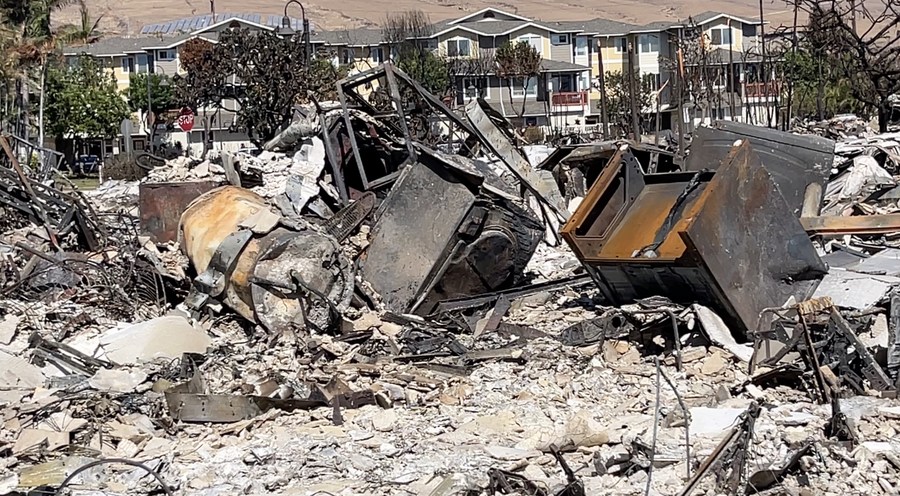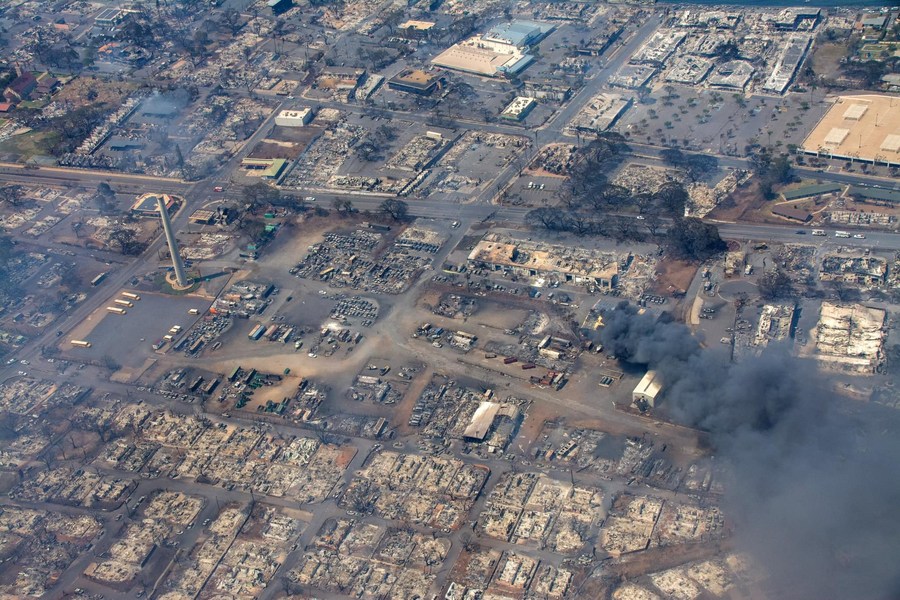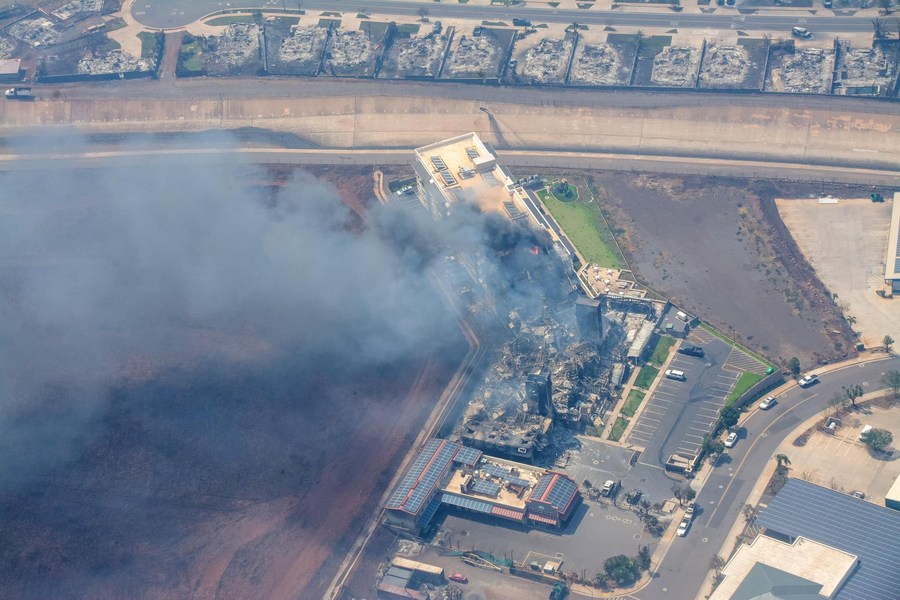The death toll from the Maui wildfires in the U.S. state Hawaii reached 110 on Wednesday, Hawaii Governor Josh Green said at a press conference. Green previously said that the death toll could rise significantly as search efforts continue.
Maui Island is the second-largest island of the Hawaiian Islands, with a population of more than 100,000. Lahaina, a historic town on Maui Island, with about 13,000 residents, witnessed the most devastating damage. In total, 2,200 structures, 86 percent being residential buildings, were destroyed by the wildfires. Green said the damage was estimated at close to 6 billion U.S. dollars.
Both the survivors of the disaster on Maui and local media have been asking for days: Why were the wildfires so devastating? Why were the losses so severe?
A combination of factors, including the “explosive spread” of wildfires, insufficient government warning and delayed relief, among others, might have caused the tragedy.
1. Why the explosive spread of wildfires?
From a natural perspective, strong winds, drought, and flammable vegetation combine to create conditions for the “explosive spread” of wildfires.

The photo taken with a mobile phone on Aug. 14, 2023 shows the aftermath of wildfires in Lahaina town, Maui Island, Hawaii, the United States. (Photo by Yang Pingjun/Xinhua)
Climate experts point out that global climate change in recent years has made extreme weather disasters, including wildfires, more intense.
Although Hurricane Dora passed just a few hundred kilometers south of the Hawaiian Islands, it intensified the low-pressure system and increased the pressure difference, resulting in strong winds. Winds of more than 100 to 130 km per hour were reported in parts of the island when the wildfires broke out.
The drought on Maui Island has intensified in recent months, with relevant agency data showing that 85 percent of Maui Island is currently experiencing a moderate to severe drought. Flash droughts are so dry and hot that the air literally sucks the moisture out of the ground and plants in a vicious cycle of hotter and drier. So a lot of dry vegetation is flammable.
In addition, Native Hawaiian and local media also pointed out the dangers of invasive exotic plants on the islands as these may become “fuel” for fires.
“The gross mismanagement of land by greedy developers and land speculators destroyed our natural landscape and buffers and enabled the rapid spread of the fire,” Kaniela Ing, an environmental activist and former Hawaiian legislator, said, blaming “colonial greed” on Twitter.
The Hawaiian islands used to have large pineapple and sugarcane farms, but with the rise of tourism in the process of economic transformation, large areas of the local plantations were gradually abandoned, and the fast-growing but flammable exotic grass seeds began to spread, covering about a quarter of the land in Hawaii. These weeds thus became ideal “fuel” for the spread of fires.
As a result, a combination of factors has contributed to the explosive expansion of the Maui wildfires. Governor Green said the wildfires were moving at a speed of 1 mile (1.6 km) per minute.

Photo released by County of Maui on Aug. 10, 2023 shows houses destroyed in a devastating wildfire on Maui Island, Hawaii, the United States. (County of Maui photos/Xinhua)
2. Why the lack of warnings?
In Maui, it’s not difficult to spot one of the 80 green siren towers used to alert residents in times of danger, which are tested monthly. The noise, as loud as a rock concert, can be detected from more than half a mile away.
During natural disasters — including wildfires — Maui County said the sirens are designed to blast a steady three-minute noise to inform the public to seek further instructions on their local radio or television station.
What’s puzzling is that the robust emergency siren warning system simply sat silent during the deadly wildfires.
Many survivors said there wasn’t really an evacuation notice for them. The real warning, sadly, came from the “huge plume of black smoke” in the sky over Lahaina.
The Hawaii Emergency Management Agency’s spokesman, Adam Weintraub, said local officials did not activate the siren system and failed to explain why, according to an NPR report. Weintraub added that he emphasized that three other warning systems were used, such as alerts to cellphones and through TV and radio stations.
Worse still, firefighters sent to tackle the flames found some hydrants had run dry, The New York Times reported on Sunday.
“There was just no water in the hydrants,” the newspaper quoted firefighter Keahi Ho as saying.
Hawaii’s attorney general Anne Lopez said the failure of the alert system is under investigation.

Photo released by County of Maui on Aug. 10, 2023 shows houses destroyed in a devastating wildfire on Maui Island, Hawaii, the United States. (County of Maui photos/Xinhua)
3. Why the slow rescue?
At least 110 people have perished in the fires and hundreds are still unaccounted for. Destitute residents said they have had to turn to each other for assistance as the government response at all levels has been inadequate or absent.
Residents have been forced to take charge of their own wildfire recovery efforts in light of what some are blasting as an incredibly slow response by the federal government.
“The Hawaiian people, the locals that have lived here, they just always feel like they’re the last to be thought of. And they’re, like, the foundation of it,” professional surfer and Maui resident Kai Lenny said.
Other residents have launched their own fundraising efforts such as the “Help Maui Rise” Google spreadsheet created by locals.
The Federal Emergency Management Agency (FEMA) said it has deployed some 300 employees to Maui, while the Red Cross has sent 250 disaster workers, CBS News reported.
The agency has been criticized in the past for its responses to major disasters, like Hurricane Katrina in New Orleans in 2005 and Hurricane Maria in Puerto Rico in 2017.
In many cases, the criticism centered around accusations that it was not adequately prepared or slow to respond. At least a few Maui residents have questioned why the agency was not already present.
The federal response will be closely watched as FEMA helps state and local officials with rescue and recovery missions after the devastating wildfires.







